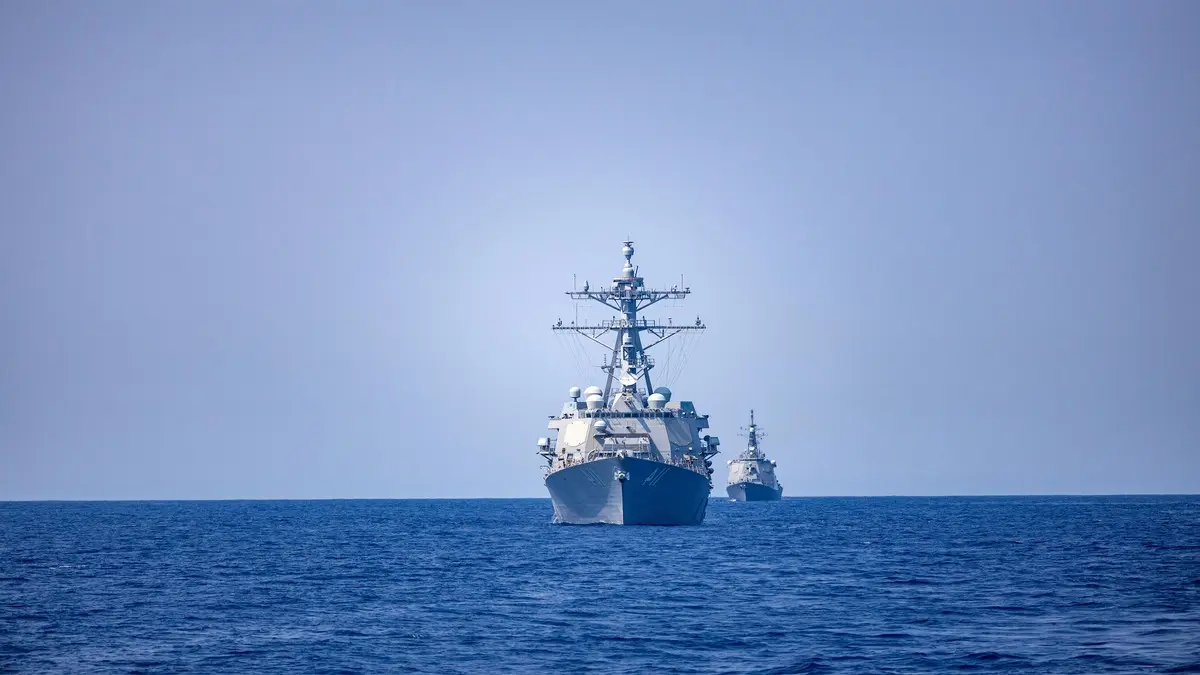“(MANILA – August 13, 2025) – The United States briefly deployed two Navy warships on Wednesday, marking a measure of the presence after a collision between a Chinese Navy destroyer and a China Coast Guard cutter while maneuvering to stop a small Philippine vessel earlier this week. The Arleigh Burke-class destroyers USS Higgins (DDG-76) and USS Cincinnati (LCS-20) were operating about 30 nautical miles from the disputed atoll and were shadowed by the Chinese Navy vessel, according to Philippine officials. No incidents were reported during the U.S. transit.
What happened at Scarborough Shoal
A video released by the Philippine Coast Guard on Monday shows the BRP Suluan trying to stop the shoal The destroyer and a Chinese coast guard vessel appeared to collide, causing visible damage to both Chinese vessels. Manila said its crews had offered assistance by radio but received no response. Philippine military leaders called the maneuvers “dangerous.” The maneuvers were highlighted as risks of escalating tensions in one of the world’s busiest sea lanes.
The incident was part of a series of forced actions in waters within the Philippines’ exclusive economic zone, but claimed by China. On Wednesday, a Chinese fighter jet also intercepted a Philippine Coast Guard plane carrying journalists, coming within about 200 feet for about 20 minutes, Philippine officials said.
- USS Higgins (DDG-76), an Arleigh Burke-class guided-missile destroyer, has been involved in numerous deployments and patrols, focusing on deterrence and freedom of navigation operations. (US Navy)
Dueling stories, familiar legal fault lines
Beijing’s Southern Theater Command claimed it had “observed” and “dismissed the USS Higgins after the ship was accused of entering waters near a shoal without permission”. The US 7th Fleet called that report “false”, and said the destroyer “asserts navigational rights and freedoms… consistent with international law”
About Scarborough Shoal – 200km away – has been the subject of dispute since 2012 and sits on a conglomeration of overlapping claims. In 2016 an international arbitration tribunal invalidated China’s sweeping “nine-dash line” claims and ruled Beijing’s blockade of Scarborough illegal; China rejects the ruling, while the US regularly takes action to challenge excessive maritime claims.
Reactions from allies and regional messages
Washington’s ambassador to Manila, Merrick Carlson, condemned “the latest reckless action by China directed against a Philippine vessel” while praising the Philippine Coast Guard’s restraint. Japan, Australia and New Zealand expressed concern over the unsafe behaviour and urged compliance with international law. A Philippine Coast Guard spokesman Commodore Jay Terriella called the incident a “learning experience” for Beijing, warning that dangerous maneuvers invite miscalculation.
Why these two US ships — and why now
The multi-mission destroyer and littoral combat ship pair was a flexible mix: the destroyer’s area air-defense and long-range sensing, plus the LCS’s aviation capability, shallow-draft agility, and high speed suited to crowded coastal areas. Operating in a wide area outside the shoal’s territorial waters signals alliance commitment without entering the most sensitive waters — especially amid heightened tensions in the immediate aftermath of the Sino-Chinese clash.
- USS Cincinnati (LCS 20), a Freedom-variant littoral combat ship, conducts deterrence patrols in disputed waters, using its speed, agility, and modular design to quickly adapt to changing mission requirements. (US Navy)
Risk calculation
Benefits. For Manila, the visible US presence strengthens deterrence and reassures fishermen and Coast Guard crews who have faced increasingly dangerous encounters. It also emphasizes that in the South China Sea 1951 Mutual Defense Treaty Washington repeatedly stresses that this applies to armed attacks on Philippine. public vessels.
Risks. China has signaled that it would consider U.S. operations near it a violation, and the presence of Chinese navy, coast guard and maritime patrol vessels – often maneuvering closely – increases the potential for accidents or disturbances. A Philippine surveillance flight reported a fighter intercept on Wednesday shows how air and sea incidents can escalate in the same strategic space.
What to Watch for Next
- Operational Tempo. Whether the U.S. and partners maintain a presence near the coast—or shift assets—will determine whether this was a one-time gesture or a broader shift in posture.
- Chinese Reaction. Expect a tighter Coast Guard screen, more naval forces, and sharper information operations that portray U.S. patrols as destabilizing; Beijing already claims it has “driven away” the U.S. Higgins.
- Engagement Coordination. Manila’s resilience strategy—legal, diplomatic, and police—relies on partners. Joint patrols and capacity-building could expand, but each step will be weighed against the risks of escalation.
Read More: Taiwan Unveils Plans for New ‘Carrier Killer’ Anti-Ship Missile to Deter PLA Naval Power
FAQs
The US sent its naval ships near Scarborough Shoal to support the Philippines and keep freedom of navigation open in the South China Sea. The move came shortly after a Chinese naval destroyer and a Coast Guard vessel collided while blocking a small Philippine vessel.
Scarborough Shoal is a small reef but it lies in one of the world’s busiest sea lanes. Both the Philippines and China claim it, but an international tribunal ruled China’s claim illegal in 2016. Nevertheless, China continues to patrol and block access, making it a trending flashpoint in Asia-Pacific politics.
The patrols show how US-China rivalry is playing out in the Indo-Pacific. Washington uses the operations to challenge Beijing’s claims, while China often says the US is “stirring up trouble.” Each close call, whether at sea or in the air, heightens global concerns about a potential major conflict in the region.








Leave a Reply